How and When to Start Seeds Indoors: Timing Is Everything
Updated: Feb. 23, 2024
Learn when to start seeds indoors, what plants to grow from seed, care tips, and the right way to safely transplant seedlings outdoors.
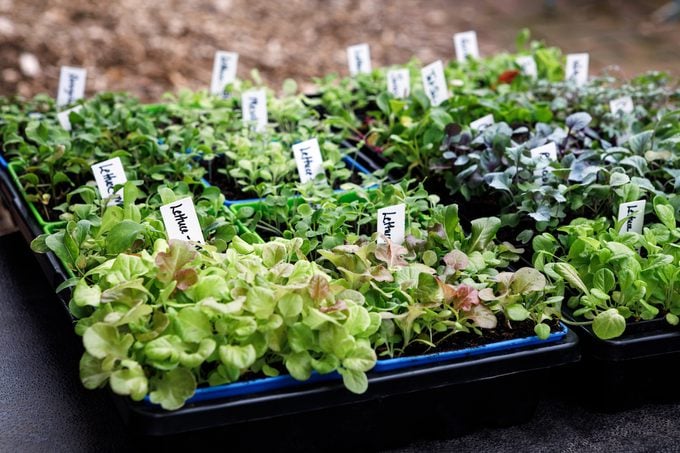
It’s easy to cure an early case of garden fever: follow these tips on how and when to start seeds indoors. Growing your own seedlings also saves money and gives you the opportunity to enjoy unusual heirloom varieties.
“It’s kind of fun to start things indoors,” says Richard Jauron, a retired horticulturist at Iowa State University. “If you’re looking for a specific variety, you may not find it locally at a greenhouse, so you can buy the seed and start it yourself.”
A fresh pile of seed packets makes gardeners yearn to get growing. But hold tight! If you start too early, you might end up with leggy, overgrown plants that need babying until the frost disappears and the soil warms. Start too late, and you’ll be drooling over your neighbor’s BLTs while forlornly waiting for your plants’ blooms to turn into fruit. Ensure your schedule is set up for success.
Check out the top 10 flowers for harvesting seeds.
On This Page
Selecting Seeds: Decide What to Grow
Deciding what to grow from seed is up to you, but Richard notes some things aren’t worth the bother. Begonias, for example, have tiny seeds that are hard to germinate and slow to mature. It’s much easier just to buy those plants at the garden center.
Fortunately, there are plenty of easy and readily available candidates, including flowers such as marigolds, zinnias, petunias and impatiens, and vegetables such as tomatoes, peppers, cabbage, kale and broccoli.
The National Garden Bureau recommends that before you sow your first seed, become familiar with that plant’s needs. Does it prefer warm temperatures, or can it tolerate a light frost? Knowing the appropriate growing season and temperature, as well as the light and soil requirements, helps you set a schedule. Many plants, such as peppers, tomatoes and some perennial flowers, need warm temperatures to germinate, making them good candidates for indoor seed starting.
Consider all seasons. While summer offers a rich bounty, spring and fall gardens offer equally extensive harvests of cool-season crops, such as broccoli and lettuce. And cool-season flowers, such as pansies and snapdragons, fill gardens with color and fragrance, so consider them when setting your list.
Check out butterfly flowers that are easy to grow from seed.
Order Seeds Early
Shop early for the best selection and to receive seeds in time to give them a great start. Most seed packets offer excellent information, such as days to germination, ideal temperature, how deep to plant the seeds, days to maturity, plant spacing, sun needs and more.
Knowing how long seeds take to germinate and mature helps you know when is the best time to start them inside. Some seeds, such as lettuce, need to be sown on top of a seed-starting mix, as they need light to germinate. And most seeds, such as borage, need to be kept in the dark until they sprout. All seedlings need light as soon as they germinate, though.
Learn how to grow coneflowers from seeds.
Check Seed Needs
For the best germination, some seeds require a bit of pampering before they’re sown. These prima donnas require more time and effort on your part.
Scarification: A seed with a thick coat can be impenetrable to the moisture and gases that trigger germination. Just as the name implies, you’ll have to scar the seed coat using sandpaper or a nail file to scratch the outer coating, allowing the seed to absorb water and begin germination.
Stratification: Certain seeds, such as poppies, require a chilling period before germination, known as stratification. Direct sow these in the fall, allowing the winter temperatures to provide the needed cold period.
If you forgot to sow seeds until there’s a foot of snow in your garden, or if your mild zone doesn’t get a good winter freeze, no worries! Check your seeds’ stratification requirements— because the length of time varies—and use your refrigerator. Fill a container or bag with perlite, vermiculite and sand, or a seed-starting mix. Moisten the mix, add the seeds and place the labeled container in the refrigerator. Make a note on your calendar about when they will be ready for planting. And never let the seeds dry out during stratification.
Soaking: Some seeds like a soaking to boost germination. A 24-hour bath in lukewarm water encourages certain seeds with a wrinkled appearance, such as nasturtium, to absorb water and begin germination. If you have plans to grow any temperamental seeds that need a little TLC for germination, factor in the additional time into your seed-starting schedule.
Find out how to collect milkweed seeds from pods.
When to Start Seeds Indoors
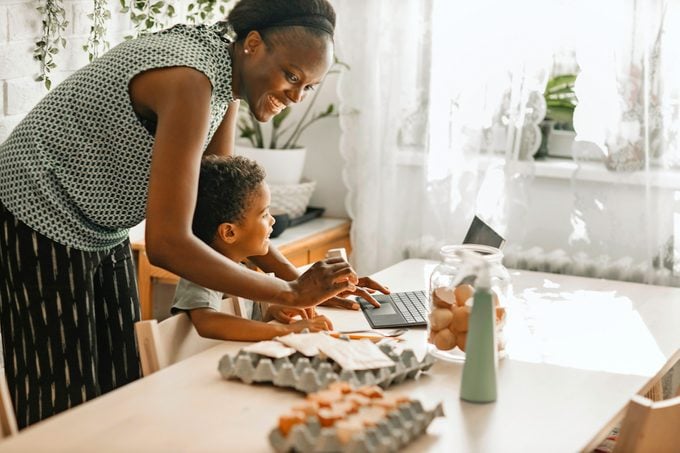
Know your last frost and first freeze dates. Of course, these dates are not foolproof—Mother Nature likes to keep us on our toes—but they’re a good place to start with your seed-starting schedule. Plan around the frost dates, but play it safe. For instance, if your last spring frost date is predicted to be April 18, consider waiting an extra week before planting tender crops in the garden. Perhaps keep a frost cover or a few cloches on hand in case of a late cold spell.
Determining when to start seeds indoors depends on where you live. Those who live in hot climates—Zones 8 or 9, for example—may be able start seeds as early as December. Northern gardeners, like those who grow in Zones 3 or 4, should wait until March or April to start most seeds, depending on the plant’s germination period.
Don’t fret if you have to wait a little longer. Extra time offers the perfect opportunity to order seeds—preferably as early as possible to get the best selection. Check out our favorite seed catalogs. Seed packets often include recommendations on when to plant indoors based on your average last frost date.
Richard cautions not to start growing too early. “Something like cucumbers or squash germinate and grow quickly, so start these inside three to four weeks before they can go outdoors,” he says. Tomatoes need five to six weeks indoors; peppers require seven to eight weeks.
Use a Seed Scheduling Tool
While you can create your own customized spreadsheet, adding in the seeds you want to grow, time to germination and days to maturity, Johnny’s Selected Seeds has an online seed-starting calculator to get you growing at the perfect time.
Plug in your last frost date, hit enter and the calculator tells you when to start each type of seed indoors. It shows the number of weeks to start seeds before the setting-out date, as well as the safe time to set out plants relative to the frost-free date.
How to Get Started Growing Seeds Indoors
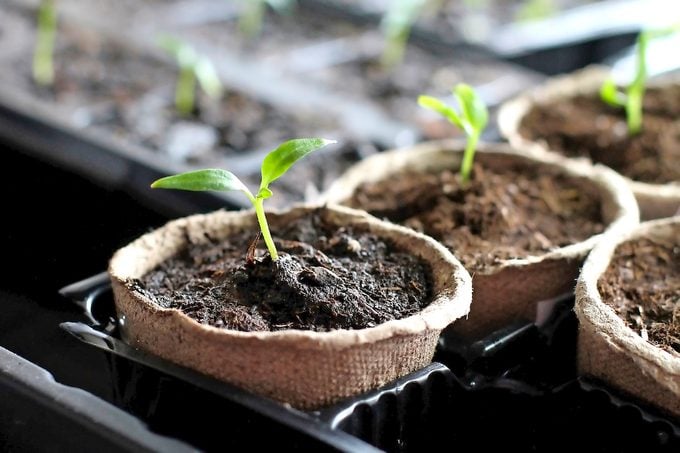
Richard starts vining vegetables in peat pots, which are biodegradable cells made of compressed peat moss that can be set directly in the ground without disturbing roots. For most other plants, he recommends plastic trays that have been washed with warm, soapy water and disinfected with a 10% bleach solution to prevent spreading disease.
Fill the tray with a commercial seed-starting mix of peat moss and vermiculite, and then sow the seed at the depth recommended on the packet. “For the seed to germinate, it needs good seed-to-soil contact,” Richard says. “And make sure they’re not too crowded.” Properly spaced seedlings are easier to transplant later.
Check out 10 fast-growing vegetables you can harvest quickly.
Boost Seed Germination With Heat
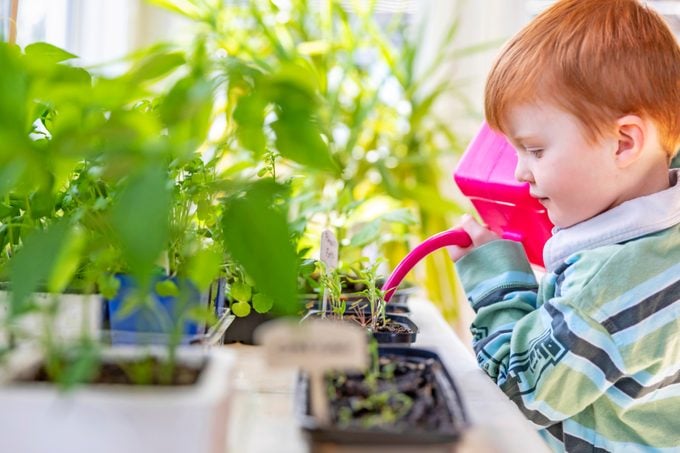
When you start seeds indoors, warmth and humidity aid germination. “You need to keep the seed consistently moist,” Richard says. After sowing, he waters the tray before stretching clear plastic food wrap across the top and securing it with tape. (Some trays are sold with clear plastic domes to create this greenhouse effect.) He then places it by a heating vent, or you can also use a heating mat specifically for plants.
“As soon as the seedlings come up, take off the plastic, put the trays under lights and let the germination medium dry out—not completely dry out but just enough to dry out somewhat—then water again,” Richard says.
Light is very important. “If you put the seedlings in a window, even a sunny window, they’re not going to get enough light, so they stretch and get very spindly,” Richard says. “I typically use an ordinary fluorescent light with two 40-watt tubes. The light needs to be very close to the seedlings when they come up, typically within 4 to 6 inches.”
Learn how and when to thin vegetable seedlings.
Hardening Off: When to Move Seedlings Outdoors
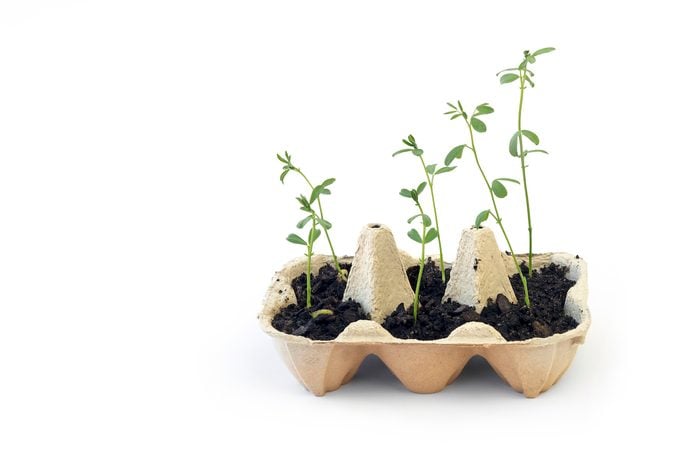
Once the seedlings develop a second set of true leaves, Richard transplants them into cell packs filled with potting mix. “I just use a knife and dig them up really carefully by hand,” he says.
When it’s time to take plants outside (see the seed packet for guidance), start by acclimating them to the conditions. This process, called hardening off, can be done by placing plants outside in the shade for a few days, gradually moving them to increase the amount of light they receive every few days.
The National Garden Bureau advises you should introduce plants to the outdoors slowly. Look for a level, partially sunny spot and give plants about an hour of outside time. Increase the amount of sunlight they receive every day until they’re in full sun. Go slow to avoid sunscald. Move plants inside if the nights are cold. Keep them hydrated, because wind and sun make them thirsty.
Conversely, if they have withstood a rainstorm, make sure to pour standing water out of the trays. When the weather is ideal and the plants have been acclimated to the outdoors for about 10 days to two weeks, you can safely introduce the plants to their new garden home.
“I like planting in the morning or in the evening, not during the heat of the day when the plants might suffer a little bit,” Richard says. “Water them well and they should be OK.” If seedlings appear a bit pale, he suggests adding a water-soluble fertilizer when watering, and wait for your plants to flourish.
Learn the best time to water plants.
Extend the Season With Succession Sowing
Some seeds produce quickly and are ideal for direct sowing in the garden. For instance, radish seeds mature in about a month so they are perfect for succession sowing. Plant some seeds every two weeks, then enjoy a continuous supply of radishes.
Top Plants to Start from Seed
These popular blooms and veggies are easy to grow start from seed.
Flowers
Vegetables
- Beans
- Broccoli
- Cauliflower
- Cucumber
- Eggplant
- Lettuce
- Squash
- Tomatoes
- Peppers
About the Expert
Richard Jauron worked as an Extension Program Specialist in the Department of Horticulture at Iowa State University. Richard provided answers to home gardeners and extension staff. He also assisted with operating the university’s Master Gardener program.
Sources
- The National Garden Bureau
- Johnny’s Seeds
Why Trust Us?
For nearly 30 years, Birds & Blooms, a Trusted Media Brand, has been inspiring readers to have a lifelong love of birding, gardening and nature. We are the #1 bird and garden magazine in North America and a trusted online resource for over 15 million outdoor enthusiasts annually. Our library of thousands of informative articles and how-tos has been written by trusted journalists and fact-checked by bird and garden experts for accuracy. In addition to our staff of experienced gardeners and bird-watchers, we hire individuals who have years of education and hands-on experience with birding, bird feeding, gardening, butterflies, bugs and more. Learn more about Birds & Blooms, our field editor program, and our submission guidelines.


